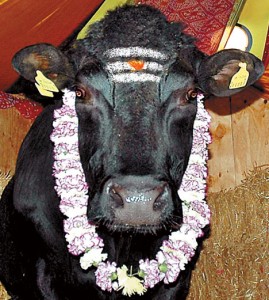 A few weeks ago, I ran a one-shot picaresque game. One of the players decided that her character, a gullible paladin, worshiped “St. Jimmy”, whose tenets were that the world is full of water and every well contains mermaids. She had been tricked into worshiping this nonexistent god by a con man who sold her a snow globe as a holy relic.
A few weeks ago, I ran a one-shot picaresque game. One of the players decided that her character, a gullible paladin, worshiped “St. Jimmy”, whose tenets were that the world is full of water and every well contains mermaids. She had been tricked into worshiping this nonexistent god by a con man who sold her a snow globe as a holy relic.
This weekend, at the Arneson Game Day event, I ran another one-shot. I recycled a bunch of pre-used level-1 character sheets, including the paladin with “St. Jimmy” written down as the deity.
During the course of the game, the players went through a magical gate into a land that time forgot, stocked with cave men and wooly mammoths. A new player, playing the recycled St. Jimmy-worshiping paladin, took the lead in negotiations. Hijinx ensued (as they so often do), involving:
- an illusory three-headed red dragon, which one of the PCs could puppeteer with a magical red glove
- a NPC dwarf (“Stout Stoutheart”) riding a cow (“Muscles”)
- a fermented milk drink brewed by the party cleric/milkmaid
Between the alcohol, the red dragon and the revelations about animal husbandry, the party successfully proselytized the cave men. They were soon gleefully grunting a pre-verbal approximation of “St. Jimmy” while carrying the PCs around on their shoulders.
When the cavemen indicated that they wanted to commemorate their new god in cave art, and asked what St. Jimmy looked like, the paladin pointed at Muscles the cow.
When the PCs were preparing to return home, they speculated about whether the portal had taken them to a forgotten caveman island or whether they had gone back in time, and, Ray Bradbury-like, totally changed the future.
I had been thinking the portal led to an isolated caveman area, but the time travel option seemed more interesting. When the party returned home, I told them, “You are disappointed to discover that nothing has changed. St. Jimmy is still the dominant deity of the pantheon, worshiped in the form of the Sacred Cow. St. Jimmy’s chief angel is still a three-headed red dragon. And kumiss is still the sacred drink.”
And that’s how two different groups of players, over the course of two one-shots, created a religion, took it back in time, and gave my campaign world a strange new chief god, without me lifting a finger.
Here’s a question for linguists: What will the name “St. Jimmy” sound like after it’s been passed down for tens of thousands of years? Apply Grimm’s and other applicable laws.








Your pantheon is unusually full of cows, and it may be partially my fault. Smidanoonan came to rat-hood while living in a city that had been erected on the back of a cow, right? And then the ratlings raided a dairy in that one game and wanted to cut the legs off a cow. Little did they know how sacrilegious they were being!
Also St. Jimmy is a guy from the Green Day musical, so that makes it even more hilarious!
[…] how my players rewrote my pantheon without me doing anything […]
“Sanctuary”?
Tuzeen Ta Chemaygh?
Wow, I had no idea what these comments meant at first, but I realize now that they are totally reasonable morphs of “St. Jimmy” and also cool god names in their own right.
Sanjimay
Satan Chimay
Stanj Imae
Sane Chim Ae
Sanchimee
Or heck just call it St. Jimmy.
It would be hilarious if the con man turned out to be just some foreigner who had at some point apparently heard a little about the old St. Jimmy and figured he could get a sale on some unsuspecting Paladin using it. Or the con man turned out to actually believe in St. Jimmy the whole time.
Tens of thousands of years is a long time. Perhaps the name becomes “Senshim” fairly quickly, and is fixed by writing. But it depends upon the language of the cavemen. Did it develop into a highly-inflected language? Then “Santoi Tiemmyo” might appear, eventually settling into something like “Soityemio” or “Sanoisio” before writing halts the progression towards ever smoother consonants and towards vowels that all sound like schwa.
Or maybe their language becomes heavily infixive, and agglutinative. Maybe “Sent Djimmi” enters the language, and grows over time with morphemes for noble, great, ancient, and milk-bearing, and comes out the other end as “Sendambosnolcreyimi,” almost always introduced with the definite honorific article “dul.” After the rise of a kingdom, and a merchant empire, and the great swine plague, and the arrival of the Hieroglyphic Empire with its Hypogriff God-King, alas, what remains after 10,000 years is the little god “Duscreimi” with its sad, cow-faced statues secreted away inside dark, moss-scented caves, garlanded by althea and hibiscus in season, and invoked by maidens as “Dubinol” to send them dreams of their future husbands (and lovers), and across the Highcloud Ranges, a small remnant of wizardly priests plots a return to the great, underground cities of their forebears, and call upon “Sinjim” to hasten their victory.